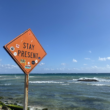
One of the highlights of our trip to Tulum was visiting the ruins in the nearby town of Coba. We woke up bright and early to catch the sunrise from the beach in front of our hotel. The coffee was waiting on the deck at 6:15a and after a quick cup we walked out to the rocks just as the first light was coming over the horizon.



Even the seagulls were up early to catch their breakfast.

After the seagulls ate it was our turn, a quick breakfast and we were on the road to Coba.
It took about an hour and a half for us to make the drive from Tulum to Coba. Unfortunately, because of the rainy season, the main entrance to the ruins was underwater from the nearby lake. They set up a temporary entrance to provide access to the site.



Once inside, we went first to the front part of the complex which had a large pyramid as well as the ball court.




After the initial site, the trail split. We headed off to the right first before doubling back and going to the left where the largest pyramid in the region was located. There were a ton of various altars and carvings spread throughout the area.





Based on my research, Coba was a large regional trading post during Mayan times and held a large cultural/social position until being overtaken by Chichen Itza.


After spending a couple of hours exploring the ruins, we headed back to the car and headed out to explore the local cenotes. A cenote is basically an underground cave, formed from collapsed limestone and filled via an underwater spring. The one we went to was completely enclosed underground. The photos here I took prior to us taking a dip.





After spending about 45 minutes diving in the cenote, we hopped back in the car and headed back to Coba to find lunch. We stopped at a roadside café just outside of the gates of the ruins where we ordered some of the local specialties and had a couple of beers to wash it down. This area was impacted by the floods as well, so we parked the car on some high ground and the restaurant had cinder blocks and crates to get you over to the front door.



The food was fantastic and the staff was extremely friendly. They clearly don’t get many American tourists and for the majority of our meal we were the only people in the restaurant. They spent time chatting with us and even offered us free tequila shots. I declined as I was driving however.


After our late lunch we drove the hour and a half back to Tulum and only missed one unmarked speed bump on the ride back. Though Coba is off the beaten path, we are very glad we made the trip out as everything felt much more authentic than the commercialized ruins and cenotes closer to town and along the main highway.






